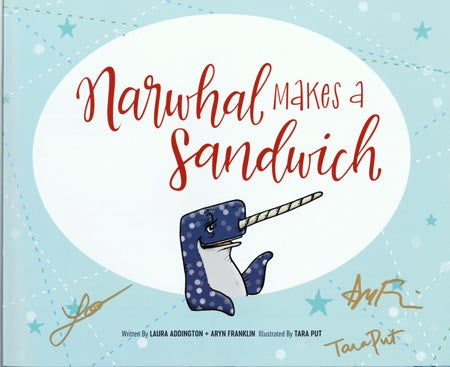Menu
-
- Home
-
About Us
-
The Approach
-
Linking Language & Literacy
-
MindWing Learning
-
Learning Resources
-
SHOP
-
Blog
-
- About MindWing
- Our People
- Contact Us
- Your Account
- Login
-
Spain (EUR €)


How To Use “Narwhal Makes A Sandwich” to Teach Story Structure & Information Text
July 20, 2017 1 Comment
 Maryellen recently received a very special package at her MindWing office in Springfield, MA. Inside was a lovely note along with a recently published children’s book, Narwhal Makes a Sandwich. This book is written by Laura Addington, a Speech Language Pathologist, and Aryn Franklin, an Occupational Therapist, and illustrated by Tara Put, also a Speech Language Pathologist. As written in the note, they used the Story Grammar Marker® to scaffold their story! We thought you would enjoy this selection outlined as a Complete Episode...
Maryellen recently received a very special package at her MindWing office in Springfield, MA. Inside was a lovely note along with a recently published children’s book, Narwhal Makes a Sandwich. This book is written by Laura Addington, a Speech Language Pathologist, and Aryn Franklin, an Occupational Therapist, and illustrated by Tara Put, also a Speech Language Pathologist. As written in the note, they used the Story Grammar Marker® to scaffold their story! We thought you would enjoy this selection outlined as a Complete Episode...

Fireflies! Story Structure, Thoughts & Feelings, Expository Features and Artwork!
July 10, 2017
 I recently came across a book, Fireflies! written and illustrated by Jule Brinkloe, that I had used to demonstrate the concept of two episodes in a story: the first episode leading to a new Kick-Off, creating a second episode. Told in the first person, the beautiful pencil drawings compliment and enhance the story of a young boy learning a valuable lesson of letting go and doing the right thing. Following, we have analyzed the book in two episodes...
I recently came across a book, Fireflies! written and illustrated by Jule Brinkloe, that I had used to demonstrate the concept of two episodes in a story: the first episode leading to a new Kick-Off, creating a second episode. Told in the first person, the beautiful pencil drawings compliment and enhance the story of a young boy learning a valuable lesson of letting go and doing the right thing. Following, we have analyzed the book in two episodes...

Tech Tuesday: This summer, play “Duck Duck Moose” to consider narrative and expository language-building opportunities
June 27, 2017
 One helpful strategy in locating apps useful in language intervention is to know and follow (via their Facebook page, Twitter or Website) the developers. We have previously mentioned developers such as Sago Mini, Toca Boca, Social Skill Builder, and LEGO®. KHAN ACADEMY, the Edtech force known most for distribution of expository video related to curriculum, recently bought the development company Duck Duck Moose, and their terrific apps continue to be offered free of charge. In this post I’ll talk about a few of them, along with great opportunities to use them as a context or context-builder alongside MindWing’s tools for narrative and expository language development...
One helpful strategy in locating apps useful in language intervention is to know and follow (via their Facebook page, Twitter or Website) the developers. We have previously mentioned developers such as Sago Mini, Toca Boca, Social Skill Builder, and LEGO®. KHAN ACADEMY, the Edtech force known most for distribution of expository video related to curriculum, recently bought the development company Duck Duck Moose, and their terrific apps continue to be offered free of charge. In this post I’ll talk about a few of them, along with great opportunities to use them as a context or context-builder alongside MindWing’s tools for narrative and expository language development...

5+ Books for Summer
June 21, 2017
 When my children were young, one of our favorite summer pastimes was a weekly trip to our local library here in Springfield, Massachusetts. A recent visit reminded me to check out the many interesting programs available for children as well as adults. We are so fortunate! I remember teaching in the classroom and having a much anticipated visit from our city’s librarian who went over the many options for summertime fun. During my days as camp counselor, a walk with the campers to our local library was always on the agenda! A friend of mine who will be teaching elementary school this summer and I visited our local branch library to check out books for her to use to review SGM components with her students. The following are a few of the choices we made...
When my children were young, one of our favorite summer pastimes was a weekly trip to our local library here in Springfield, Massachusetts. A recent visit reminded me to check out the many interesting programs available for children as well as adults. We are so fortunate! I remember teaching in the classroom and having a much anticipated visit from our city’s librarian who went over the many options for summertime fun. During my days as camp counselor, a walk with the campers to our local library was always on the agenda! A friend of mine who will be teaching elementary school this summer and I visited our local branch library to check out books for her to use to review SGM components with her students. The following are a few of the choices we made...

Tech Tuesday: 4 (and More) Ways To Tell the Story Digitally
May 23, 2017



Last month I visited the MindWing Concepts offices to lead a small group workshop on integrating tech tools with Story Grammar Marker® and Thememaker®. One of the biggest topics of interest involved ways to use MindWing’s story and expository maps on laptops, iPads and even within Google Apps, and we spent a chunk of time exploring these possibilities. We thought that this topic could use an update on the blog, so here we go! First of all, some rationale. Why might you want to work with these tools digitally (meaning the files—PDFs—provided with your purchase of any MindWing manual, either via CD-ROM in previous years, or more recently, via a free download code within the manual)? A few reasons:...

DIY Hands-On Activities For Narrative/Expository Text-Based Questions
May 19, 2017
 As I was reviewing blogs written last year at this time in May, I came across one (Magnetic Spinner Activity for Narrative Expository Text Questions) that used the Narrative/Expository Text-Based Question Cards from MindWing’s The “Core” of the Core manual (pages 171-182). This manual is chock-full of ideas for classroom use, both whole group and small group instruction. These narrative and expository questions may be used for both fiction and nonfiction. All you have to do is print them, laminate, and cut… then choose the ones which reinforce your student goals. The questions are easily paired with your current reading selections and with SGM maps. You may also add your own questions, modified for your students, but the ones presented will certainly get you started!...
As I was reviewing blogs written last year at this time in May, I came across one (Magnetic Spinner Activity for Narrative Expository Text Questions) that used the Narrative/Expository Text-Based Question Cards from MindWing’s The “Core” of the Core manual (pages 171-182). This manual is chock-full of ideas for classroom use, both whole group and small group instruction. These narrative and expository questions may be used for both fiction and nonfiction. All you have to do is print them, laminate, and cut… then choose the ones which reinforce your student goals. The questions are easily paired with your current reading selections and with SGM maps. You may also add your own questions, modified for your students, but the ones presented will certainly get you started!...
